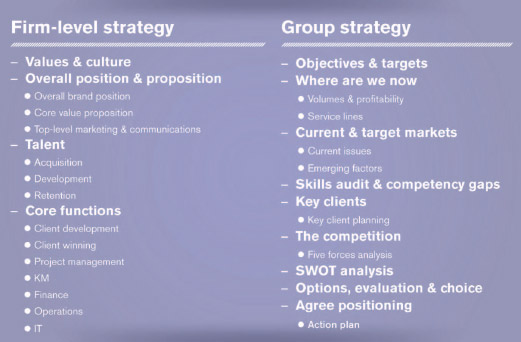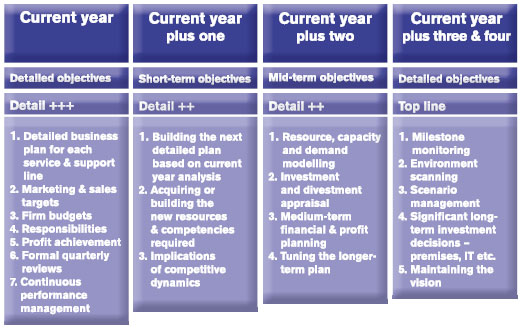Home » BLOG » Business Development » Horizon Plan
Horizon Plan
Published in Managing Partner Magazine
Andrew Hedley discusses how continuous planning can help you to improve the implementation of your firm’s strategic vision.
It is self-evident that, without a clear and robust approach to implementation, even the most well-crafted of strategic plans will founder. A continuous longerterm planning cycle is required. This article considers how such an approach may be developed in law firms.
When thinking about strategy, there are some ‘big issue’ questions that should be considered (see box: Strategic questions on the big issues). These are all forward looking and implicit in each is the notion of change, adaptation and dynamism. These big issues are not fixed in time; they are moving continuously, dynamically and unpredictably.
However, in many firms, strategic planning either takes place on a fixed cycle (every three or five years) or, worse, on an ad hoc basis, driven by emerging challenges rather than opportunities. Neither of these approaches is appropriate; a planning cycle more suited to modern times is needed.
In developing such an approach, it is important to be clear that strategy making is continuous, not episodic. The days when a five-year plan could be produced and then followed slavishly for the next fourand- a-half years before the next five-year plan was considered are now long gone (if they ever existed at all). Strategising only in response to a crisis has never been appropriate, and never less so than today.
Strategic planning is much more akin to a journey is which the ultimate destination is clear (i.e. the firm’s long-term vision), but the means by which one might achieve it are flexible.
It is difficult to plan much further ahead than the current time horizon (of say 18 months) with any degree of confidence. Yet, it is imperative to do so if you are to:
- position your firm attractively in the market (for both clients and employees);
- make long-term investment decisions;
- manage risks; and
- operate a business model that delivers levels of profits to your owners that are both acceptable and sustainable.
In this journey-based approach to achieving a strategic vision, the terrain (or competitive environment) may change – from a smooth highway to a treacherous swamp and back again – while the mode of transport (for example flexible resources, IT and KM) will develop in ways which create both huge challenges and significant opportunities. What is needed is the ability to adapt to these dynamics while keeping the overall destination clearly in mind.
Strategic management cycle
To put this into context, consider Figure 1, which maps the strategy development process and has been used with great success in law firms both as a diagnostic tool and a framework for developing strategies.
When using this model as a diagnostic tool, it becomes clear that the strategy process is often perceived by the leadership team to end with the creation of a strategy route map (at best) or even simply the agreement of a series of strategic objectives and headline strategy statements.
Figure 1: The strategic management process

The translation of broad strategy statements into a series of planned activities, behaviours, processes and cultural changes is simply not considered in anything like the detail they should be. But, any strategy will only have life if this translation takes place effectively. Misalignment between the long-term strategy and short-term business plan leads to underperformance and a divergence, over time, between where the firm is aiming to get and where it is headed.
Another commonly-overlooked feature is that strategic management is a continuous process. The three stages of analysis-planning-implementation are cyclical. The learning from the implementation phase provides the starting point for the analysis phase of the next iteration.
Many managing partners pursue a strategy review as a one-off event-in-time rather than as an opportunity to orientate their firm for the future, to reaffirm and clarify their overall objectives, to assess their progress and to plan for the next phase of the journey.
Strategy meets operations
The misapprehension that the strategy process starts with analysis and ends with the choice of a strategy and the production of a series of headline statements of intent is common. It is inevitable that the underpinning plans and resources needed to provide the basis for delivering the strategy are neglected or given insufficient priority.
Without these detailed plans, any success will be a matter of serendipity. Even at an early stage, it is vital that a layer of operational granularity is added to ensure that the implications for the firm in achieving its overall strategy are fully understood and expressed through a series of sub-strategies.
In the initial phase, such thinking will inform decision making as to which option to pursue or to stress-test assumptions. This should be done at the planning stage to avoid the risk of the strategy becoming undone because the building blocks upon which it is based are unsafe, with the firm not having the resources or skills needed to deliver them.
For example, a firm’s strategy may include a commitment to improvements in efficiency through an increased deployment and more effective use of advanced IT systems. What might the implications be?
Even in this simple case, coordinated plans will be needed across a number of interdependent operational areas, such as:
- IT (to scope, purchase, implement and support any new systems);
- HR (to recruit and train the people to effectively deliver the new approach);
- accounts (to finance the acquisition and ongoing system support in the most effective way possible);
- KM (to scope with IT and work with operations in the implementation); and
- the practice groups (to change working practices, up-skill people in the use of more advance IT and manage the client delivery process.)
Without planning, commitment and coordination at this level, the headline strategy will not be achieved.
Any statement of strategic intent has a potential impact across the business, which needs to be considered across three dimensions:
- The immediate implications for the team or department in delivering against the objective;
- HR (to recruit and train the people to effectively deliver the new approach);
- The inter-relationship and impact across departments or functional teams and how this is managed;
- The opportunity cost of the activity – the things that we will not do, or the trade-offs that we will have to make, in order to achieve this objective.
These interactions can be better understood by creating sub-plans in which each functional area – business support department and practice group – considers its own sub-strategy that will be needed to achieve each of the firm’s overall objectives.
Nesting the plans
Alongside the setting of the Firmwide strategy, planning should be conducted at the next level of detail whilst still considering issues in broad terms. These second tier plans will nest within the overarching strategy framework, both aligned with and subservient to it.
Planning at this level allows the broader leadership team to consider inter-relationships, identify resource pinch points and assess the critical paths which may affect both the sequencing and timing of any project implementation.
Take for example the relationship between the Firm level strategy and a Practice Group seeking to support it (as illustrated at Figure 2). In this hierarchy, the Firm Level plan sets the overall direction for the business and takes the lead in ensuring that the cross-group infrastructure needed to deliver it is put in place.
Figure 2: Levels of strategy

It then falls to each practice group plan to consider how the relevant aspects of the firm’s overall vision and strategy apply within its domain of activity. The resources which the practice group seeks to direct and over which it has management control are more tightly defined. Complete clarity as to where these boundaries lie is needed.
It should also be clear that the most critical point at which any plan is given life is the client interface, which is managed and controlled in large part at practice group level.
It follows that the practice group strategy must be fully aligned with the firm’s overall direction – there should be a clear line of sight between it and the overarching vision. Subsequent adjustments to the top line should be managed cross functionally in order to ensure that this alignment is maintained.
A firm whose headline strategy targets one set of objectives but in which practice groups are simultaneously forging different or dissonant paths will quickly become tangled in internecine fighting and external confusion.
There are techniques available, such as strategy mapping, which can assist with this process. However, for many firms, a simple table analysing the implications of each objective across the firm’s practice and business support functional areas may be enough. This should highlight immediate areas of concern and give direction to operational strategy planning.
Planning on the move
To plan in a fast-changing world, a methodology is needed that caters for current circumstances and conditions, looks to the future in terms of the firm’s vision and bridges the gap between the two with an incremental planning approach.
Such an approach is set out in Figure 3. In this model, there are four tiers of the plan, moving from the current year to a horizon four or five years hence. It is important to note that this model does not talk about year one, two, three, and so on of the planning cycle – only the current year and those ahead of it.
Figure 3: The continuous planning cycle

This is more than a semantic point – it underpins the philosophy of continuity.
Of course, that is not to say that time-bound objectives do not exist (or that they are not worked towards and delivered within the context of the detailed plans), but rather that the stop-start planning cycle to which we have become accustomed is consigned to history.
The current year plan must provide the detail required to manage and make decisions on a daily basis. It must be sufficiently detailed to allow the management team to monitor progress, judge performance and ensure that financial objectives are met. It must also be clearly communicated so that those charged with its delivery are able to understand what is required of them in terms of their annual performance targets and have the mandate to move forward autonomously to achieve them.
This detailed business plan will set out the budgets (revenue and expenditure) and the means by which each will be achieved, for example through sales and marketing plans, allowing progress to be tracked, variance assessed and actions taken to close any gaps.
Such yearly business plans should be ‘meat and drink’ to the competent management team. It is when one moves beyond the 12-month horizon that things become a little more uncertain.
Looking to the second year in the cycle, what are the appropriate planning measures that should be contemplated now so that the more detailed layers of complexity can be added as they move into the orbit of the next 12-month plan? In particular, are the new skills and competencies that will be needed in the next cycle being acquired?
Are there changes afoot in the market generally, with key clients or client groups specifically, and among direct competitors that will impact the firm over the next period and which need to be factored into your thinking now? Do such considerations affect your overall strategy? What are the tactical challenges that you need to plan for now?
Looking further into the future, what are the key areas in which the firm needs to reshape itself? This may be in terms of practice areas, client types, geographic footprint or ownership structure, for example. The strategy for any major investment, divestment or structural changes will generally require a longer-term horizon for activities to be undertaken, decisions to be made and the ground prepared well in advance.
Further afield, the firm should be scanning for long-range developments and evaluating the impact of potential changes in the macro environment on both itself and its clients.
Scenario planning techniques and a clear process (such as that illustrated in Figure 4) can be helpful in guiding the strategy team and identifying those scenarios that are relevant to the firm.
Figure 4: A process for scenario planning

Once the potential scenarios are identified, their possible implications and how they might be accommodated within the current strategy should be considered. Is an adjustment needed or, if their impact is significant, is a broader change to the strategy required?
The important point here is that such thinking is being done significantly in advance of when any impact will be felt. This gives the firm ample time to incorporate the necessary actions into its plans, which will become incrementally more detailed as they mature and their incorporation into the 12-month business plan approaches.
A competitive approach
The adoption of a continuous approach to strategic planning requires a change of mindset in many law firms. There is no longer a planning season, with the leadership team squirreled away in an intense series of meetings and consultations, but rather an approach is taken that rests on continuous intelligence and adjustment.
Which sailor would strike anchor, set the sails and expect to arrive at his destination without any further intervention? In good conditions with a constant breeze, fewer adjustments may be necessary, but the good navigator will always be seeking efficiency. In uncertain weather or under competitive race conditions, sail-trimming is continuous and progress is monitored constantly.
The leaders of modern firms need to be simultaneously horizon gazing and scrutinising the daily performance dashboard of their firms. They need to marry the short-term tactics and adjustments that are needed to cope with transient conditions, while maintaining the firm’s overall trajectory.
A continuous approach to planning provides the mechanism by which this apparently flip-flop behaviour can be achieved in a structured and clear way.
This article was published in October 2012 by the Managing Partner magazine. To read the original article click here.
Search
Categories
Recent Posts
- Fighting fit
- The Challenges Of Leadership Are Different To The Challenges Of Management
- The Cultural Dimensions Of Leveraging Institutional Knowledge
- A knowledge-led approach to business development is key to law firm resilience
- Team Morale Is Directly Linked To The Ability To Deliver Differentiated Client Services
